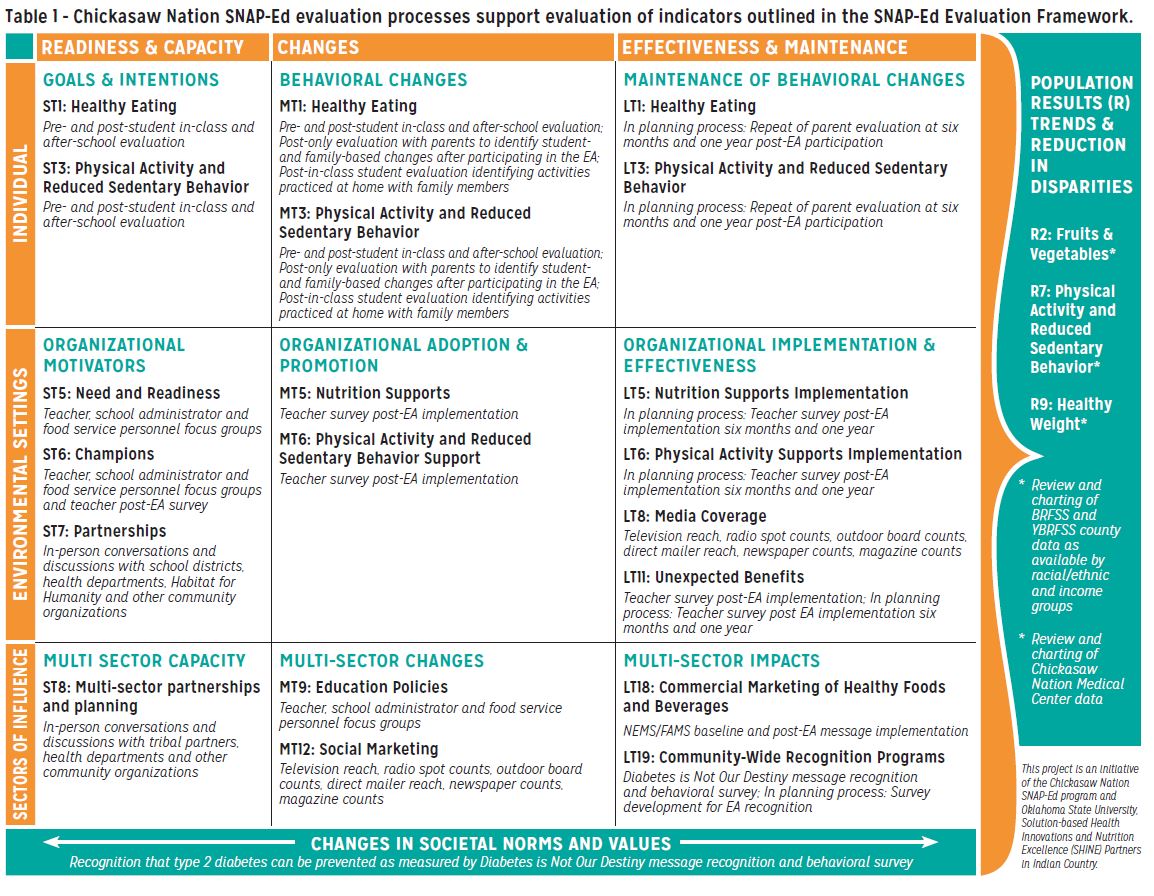The Eagle Adventure program was developed through a collaboration between the Chickasaw Nation Nutrition Services SNAP-Ed Program and the Oklahoma State University Department of Nutritional Sciences’ Solution-based Health Innovations and Nutrition Excellence (SHINE) partnership in Indian Country. In 2009, the systematic program was designed for youth and their families in grades one through three after extensive formative research indicated type 2 diabetes as a major concern among parents and elders. Recognizing multiple levels of influence are necessary to impart behavioral change, the team used the socioecological model (SEM) as the framework for development of the program and evaluation processes.
Eagle Adventure includes culturally relevant in-class education and take-home, family-based health homework (Individual), school announcements (Environmental Settings), news and radio (Sectors of Influence) to infuse and evaluate consistent messages at multiple levels of the SNAP-Ed Evaluationa Framework. An after-school component was designed as part of the coordinated approach to allow for increased exposure to healthful messages and moving activities in the after-school environment. Additionally, a complementary social marketing campaign, “Diabetes is Not Our Destiny,” was designed to reach multiple generations with consistent messages conveying type 2 diabetes is preventable through healthy lifestyle behaviors, such as fruit, vegetable and physical activity choices.
The team conceptualizes educational approaches as “living,” in that evaluation informs best practices, program changes and expansion. We continuously work with evaluation results to “build out” approaches to address multiple levels of influence, including policy, systems and environmental change efforts. The evaluation processes (Table 1) were developed in coordination with program development and are informed by the SEM. The indicators are consistent with SNAP-Ed guidance and easily align with the SNAP-Ed Evaluation Framework. Since the release of the framework and extension of programming cycle, the team has used the framework as a guide to identify opportunities and processes to address effectiveness and maintenance and population level components of the framework. Conceptualizing program and evaluation as living and working to build out programming to address multiple levels of influence has enabled the team to easily embrace the SNAP-Ed Evaluation Framework.
Peer reviewed articles/reports:
Angelina Stovall-Amos, Stephany Parker, Sara Mata, Jill Fox, Teresa Jackson, Sarah Miracle, & Janice Hermann. 2014. Eagle Adventure: School-Based Type 2 Diabetes Prevention Program Results in Improved Outcomes Related to Food and Physical Activity. Journal of Extension [Online], 52(6) Article6TOT6. Available online at: Eagle Adventure: School-Based Type 2 Diabetes Prevention Program Results in Improved Outcomes Related to Food and Physical Activity (joe.org)
U.S. Department of Agriculture, Food and Nutrition Service, Office of Research and Analysis, SNAP Education and Evaluation Case Study Report: Chickasaw Nation Nutrition Services’ Eagle Adventure Program by Stacy Gleason, Jonathan Blitstein, Vivian Gabor, Sheryl Cates, Loren Bell, and James Hersey. Project Officer: Sara Olson, Alexandria, VA: January 2012.
Teresa Jackson, Stephany Parker, Janice Hermann, Sarah Miracle, Chiquita Briley. 2012. Understanding Native American Women’s Views of Physical Activity to Inform Family-Based Program Development. Journal of Extension[Online], 50(4) Article4T0T7. Available at: Understanding Native American Women's Views of Physical Activity to Inform Family-Based Program Development (joe.org)
Stephany Parker, Toma Hunter, Chiquita Briley, Sarah Miracle, Janice Hermann, Jean Van Delinder, and Joy Standridge. 2011. Formative Assessment Using Social Marketing Principles to Identify Health and Nutrition Perspectives of Native American Women Living within the Chickasaw Nation Boundaries in Oklahoma. Journal of Nutrition Education and Behavior. 43(1), 55-62.

